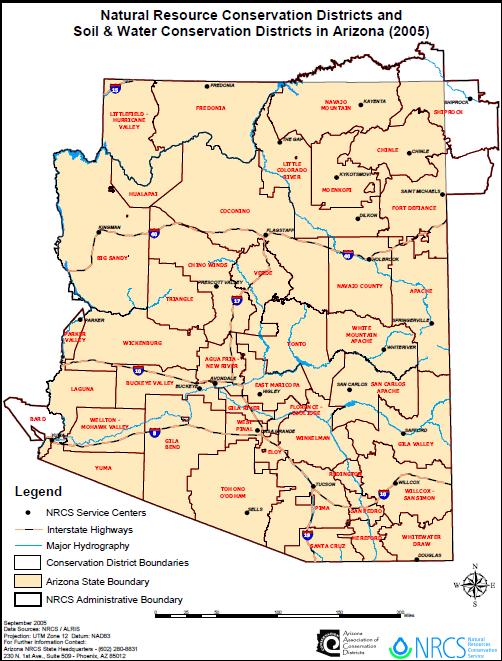Arizona’s NRCD’s and the Santa Cruz NRCD
Arizona passed its Conservation District Law in 1941. That legislation described its mission as follows: “It is declared the policy of the legislature to provide for the restoration and conservation of lands and soil resources of the state, the preservation of water rights and the control and prevention of soil erosion, and thereby to conserve natural resources, conserve wildlife, protect the tax base, protect public lands and protect and restore this state’s rivers and streams and associated riparian habitats, including fish and wildlife resources that are dependent on those habitats, and in such manner to protect and promote the public health, safety and general welfare of the people”. By 1942, the Secretary of State certified eight Natural Resource Conservation Districts (NRCDs) in Arizona. Now, in 2012 there are 41 districts in Arizona. Of the 41, 9 are Soil and Water Conservation Districts (SWCDs). SWCDs and NRCDs have the same basic objectives except that SWCDs are administered under tribal law. NRCDs are political subdivisions of state government and are administered under state law through the Arizona State Land Department. See Arizona’s District map below:

The Santa Cruz NRCD was formed in 2001 after separating from Pima NRCD. Its authorities are listed in the Arizona Revised Statutes, Title 37, Section 1054. The Santa Cruz NRCD is located in Santa Cruz County on the upper reaches of the Santa Cruz River. It includes mainly rangeland which is characterized by desert grassland, oak woodland, and some pine forests at higher elevation. Most of the land is used for ranching, wildlife recreation, and watershed protection. Limited areas of farmland also occur.Land and ownership in the Santa Cruz NRCD is a mix of private, State, and federal lands. The District is committed to supporting policies and practices that are economically feasible, socially acceptable, and environmentally responsible. The NRCD is also dedicated to helping provide financial and technical assistance to cooperators through collaboration with other agencies and organizations. The District has identified five key resource problem areas to be addressed:
- grazing management,
- water management,
- natural resource education,
- resource planning assistance
- Erosion Control/Flood Mitigation
These areas are addressed through a variety of programs in cooperation with other agencies or groups such as the University of Arizona Extension Service, NRCS, U.S. Forest Service, Arizona Game and Fish Dept., Dept. of Water Resources, Arizona State Land Dept., Santa Cruz County, and numerous landowners and cooperators.
Activities carried out involve range management workshops, range monitoring workshops, display and demonstration projects, drought preparedness through the Local Area Impact Assessment Group, involvement as a cooperating agency in the land use planning process for federal lands, and on the ground projects for bank stabilization, erosion control, and check dams. Clink on District Map link: SantaCruz_DistrictMap
Santa Cruz Education Center: 2018 Ranch Days – 1,147 visits
.
